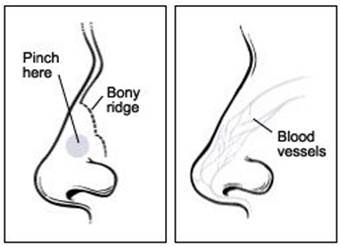Our Locations
4275 Steels Pointe Rd.
Stow, OH 44224
330.923.0399
330.923.6677
4016 Massillon Road, Suite C
Uniontown, OH 44685
330.899.9650
330.923.6677
Nosebleeds
Causes Of A Nosebleed
Most nosebleeds (epistaxis) are mere nuisances. However, some can be quite frightening, and a few even life threatening. Physicians classify nosebleeds into two different types:
Anterior nosebleed: Most nosebleeds begin in the lower part of the septum, the semi-rigid wall that separates the two nostrils of the nose. The septum contains blood vessels that can be broken by a blow to the nose or the edge of a sharp fingernail. This type of nosebleed comes from the front of the nose and begins with a flow of blood out one nostril when the patient is sitting or standing.
Posterior nosebleed: More rarely, a nosebleed can begin high and deep within the nose and flow down the back of the mouth and throat even if the patient is sitting or standing.
Additional Causes Of Nosebleeds:
- Allergies, infections, or dryness that cause itching and lead to picking of the nose
- Vigorous nose blowing that ruptures superficial blood vessels in the elderly and in the young
- Clotting disorders that run in families or are due to medications
- Fractures of the nose or of the base of the skull that can cause bleeding and should
be regarded seriously when the bleeding follows a head injury - Rarely, tumors (both malignant and nonmalignant) have to be considered, particularly
in the older patient or in smokers.
Types Of Nosebleeds
When the patient is lying down, even anterior (front of nasal cavity) nosebleeds may seem to flow posteriorly, especially if the patient is coughing or blowing his nose.
Ohio ENT & Allergy stresses that it is important to try to make the distinction since posterior (back of nasal cavity) nosebleeds are often more severe and almost always require a physician’s care. Posterior nosebleeds are more likely to occur in older people, persons with high blood pressure, and in cases of injury to the nose or face.
Anterior nosebleeds are common in dry climates or during the winter months when heated, dry indoor air dehydrates the nasal membranes. Dryness may result in crusting, cracking, and bleeding. This can be prevented if you place a bit of lubricating cream or ointment about the size of a pea on the end of your fingertip and then rub it inside the nose, especially on the middle portion of the nose (the septum).
Stopping A Nosebleed
As a self-help measure, Ohio ENT & Allergy recommends that the patient first try to stop a nosebleed by pinching the area just below the bony ridge of your nose where the highest concentration of blood vessels in the nose are located. As you pinch, you should breathe through your mouth only. However, if bleeding persists for an extended period of time, usually more than 20 minutes or so, you should seek medical attention and examination by an ENT physician.

Treatment For Nosebleeds
Ohio ENT & Allergy suggests any of the following lubricating creams or ointments. They can all be purchased without a prescription: Bacitracin, A and D Ointment, and Polysporin. Up to three applications a day may be needed, but usually every night at bedtime is enough. A saline nasal spray will also moisten dry nasal membranes.
If the nosebleeds persist, you should see your doctor. Using an endoscope, a tube with a light for seeing inside the nose, your physician may find a problem within the nose that can be fixed. He or she may recommend cauterization (sealing) of the blood vessel that is causing the trouble.
What About Rebleeding?
To prevent rebleeding after initial bleeding has stopped:
- Do not pick or blow nose
- Do not strain or bend down to lift anything heavy
- Keep head higher than the heart
- Use a humidifier during dry winter months
If rebleeding occurs:
- Attempt to clear nose of all blood clots
- Spray nose four times in the bleeding nostril(s) with a decongestant spray such as
Afrin or Neo-Synephrine
- Perform steps 1 and 2 shown in the “Stopping A Nosebleed” section.
Repeat these steps as necessary
- Call your doctor if bleeding persists
